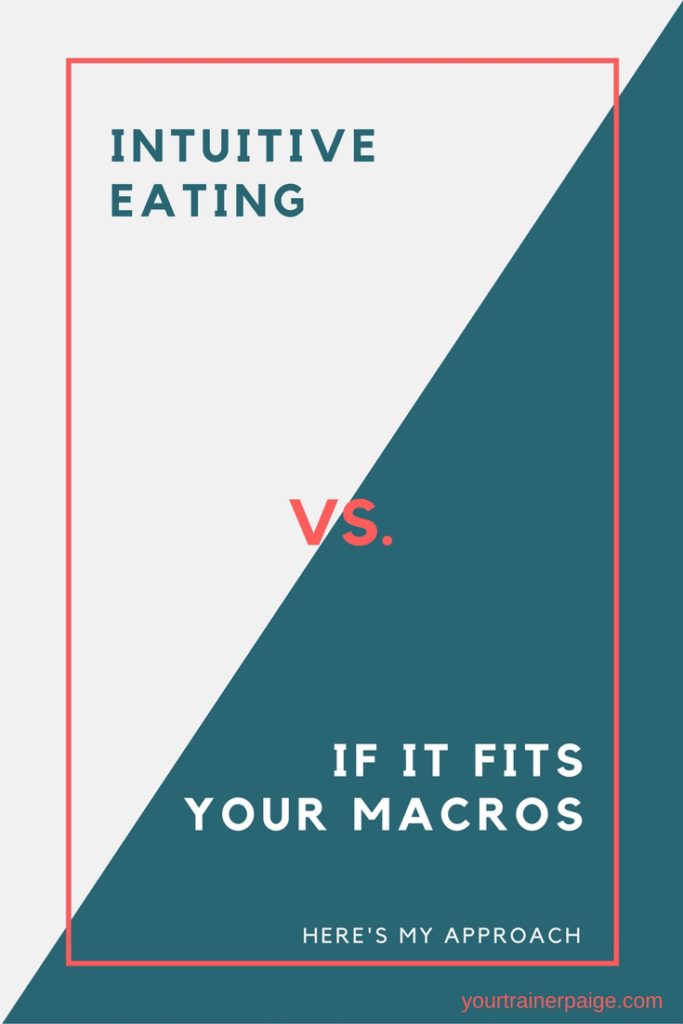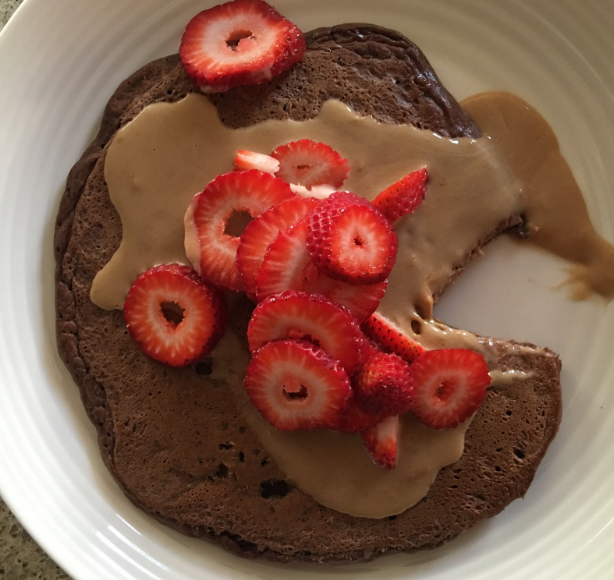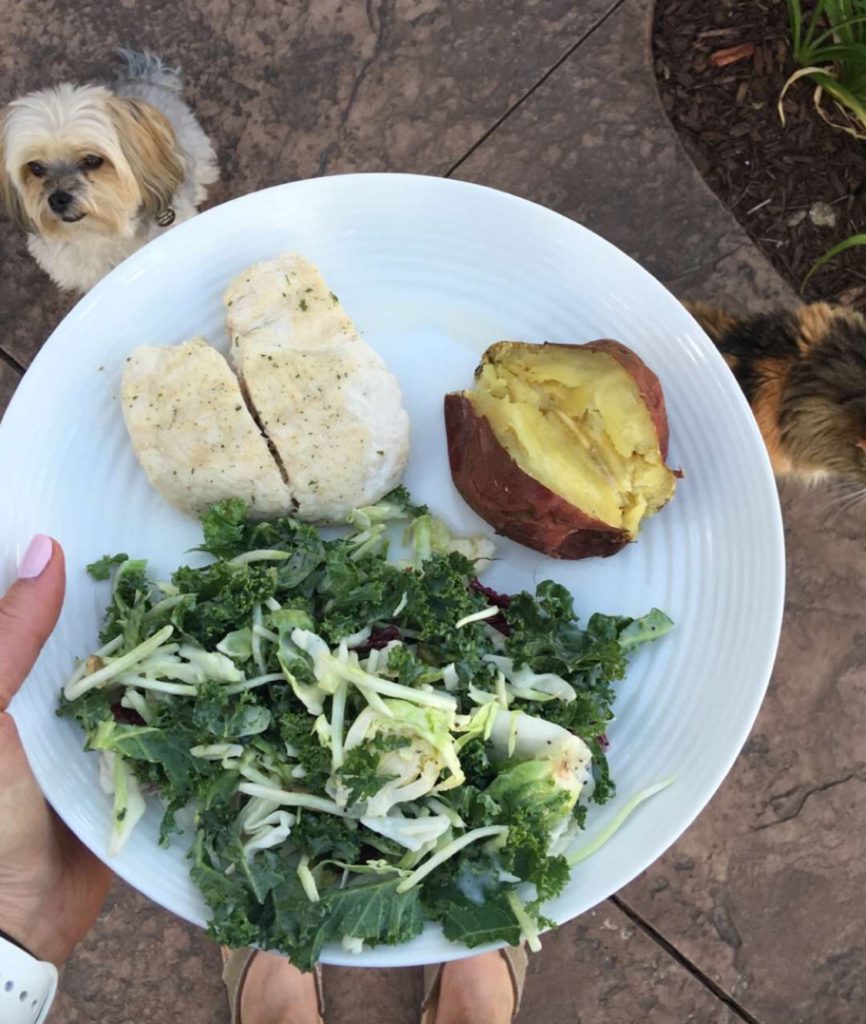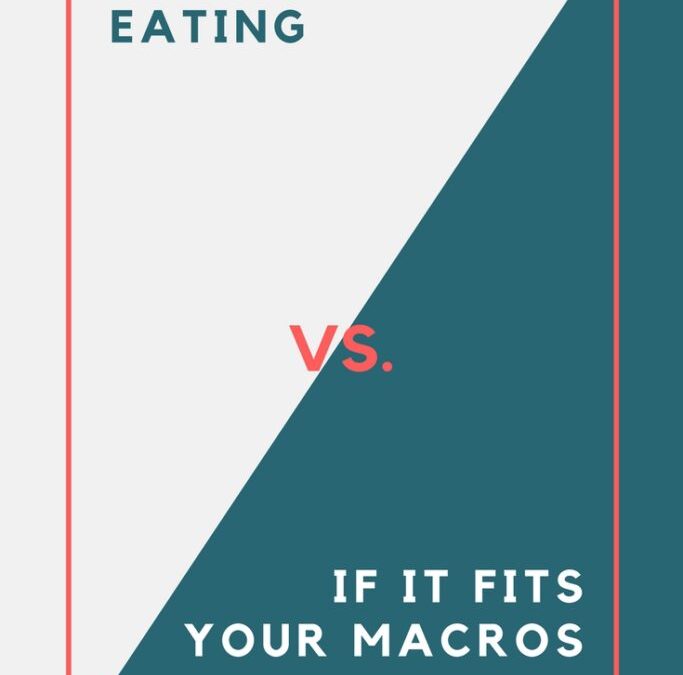Some thoughts and discussions from me.

Good morning!
The other day on Snapchat, I posted a video of the PBJ I had just made myself for lunch, and mentioned that I am currently practicing an Intuitive Eating approach to my nutrition. A couple snapchat friends asked me to elaborate on it, so I thought I’d write this post on Intuitive Eating or IIFYM (if it fits your macros.)

Right now, I don’t have goals for fat loss. I’m in a maintenance phase, and am very much in tune with trusting my hunger signals to keep me in an energy balance. An energy balance is when we are consuming the same amount of energy/calories that we’re burning. When in an EB, our weight does not change, and we enter what’s called a “maintenance phase.”
Now, when I am trying to tighten up or lean out a bit, I do use an IIFYM approach, but it’s a bit different than what you might expect.
IIFYM Approach
When it comes to both myself and my clients, I advocate a whole foods, nutrient-rich diet, interwoven with some IIFYM principles. Now, some of my clients track grams, and some track portions of macronutrients, and some do a bit of a hybrid approach. There’s truly no wrong approach here, and it ultimately depends on what works best mentally and physically for the individual.
That said, interweaving an If It Fits Your Macros approach into my clients’ programming works really well for the majority of my clients, as it allows them to enjoy some of their favorite foods, and still stay “on plan.”

Personally, I start by tracking grams – but temporarily – only a couple weeks or so. I figure out my macros (which yes, includes some carb cycling,) make sure I feel OK on them, and that I’m where I need to be for my goals, and then feel it out in terms of what my hunger levels are, how much energy I have, how I’m sleeping, etc.
Nutrient Timing
Now, I also know what works best for me and most of my clients when it comes to nutrient timing as well. When I refer to nutrient timing, I mean the time of the day that we’re eating our protein, carbs and fats. Which meals make the most the most sense to be higher carb, higher fat, etc.
This changes slightly depending on my goals, but I manipulate nutrient timing in order to do three things:
- increase insulin sensitivity
- promote workout recovery and results
- promote fat loss
These three factors are all connected to each other as well. It’s important to use what we already know about insulin sensitivity, and that for most people, we’re most insulin sensitive at a couple different times in the day. However, there are many other variables involved here, as some have great insulin sensitivity, others have not so great IS, and most of us can take a couple measures to improve it.

I know by now what works best for me in regards to nutrient timing for general health, blood sugar, and satiety levels, as well as when I’m trying to lean out or gain strength. So I take this knowledge – and my estimated intake based on how I’m feeling into the next phase.
IIFP(ortions) Approach
As I mentioned earlier, I don’t personally enjoy tracking macronutrient grams for longer than a week or two. Some of my clients track for much longer, but this is just a personal preference. From here, I like to transition into what I call IIFYP (If It Fits Your Portions – or Servings.)
After temporarily tracking macronutrient grams, I know about how much protein, carbohydrate, and dietary fat I need with each meal and still stay on track with my goals. Honestly, this is the ultimate and eventual goal with all of my clients. I do NOT see tracking macronutrients down to the very last gram as a healthy, sustainable, lifestyle practice.

When I’m consciously tracking portions, I’m usually still trying to lean out and bring down my body fat a bit. While I never advocate or write crash diets or quick fixes, I am all about consistency and compliance – for two reasons:
- It builds healthy habits
- It’s the fastest way to se the results.
And here’s the thing: we feel better when we’re at an energy balance. Sure, getting lean if we’re overweight helps energy levels, decreases inflammation, health markers get better, etc. But – our body prefers homeostasis. When we’re in a negative energy balance one way or the other, our body doesn’t like it. Our recovery is a bit slower, we don’t sleep as well, and we tend to be a bit more fatigued. Now, this isn’t a huge deal to some, especially if you’re being smart and sustainable with your fat loss, but I want to get back to homeostasis – to maintenance – efficiently.
In my opinion, we should eventually be able to estimate how much we’re eating, without having to be a slave to MyFitnessPal, and worse, a food scale, the rest of our lives. I get especially disheartened when I see those (even PT’s, youtubers, bloggers, etc.) requiring these items as part of their daily life on a maintenance mode phase. At this point – once we’re no longer trying to lose body fat or lean out, we should be able to allow our hunger cues, our energy levels, and our knowledge of the nutrient timing and distribution that works for us. To me, this means using our intuition….which brings me to…
Intuitive Eating
This is where I’m at now. To me, intuitive eating means using what you know about your body and nutrition combined with your body’s internal signals.
Knowing that having carbohydrates first thing in the morning typically sets us up for tiredness and becoming hungry
Knowing that eating less fat and more carbs and protein after a tough workout helps me recover and feel better
Knowing that having a starch-filled meal before bed helps me sleep better
Knowing that I do best eating a higher protein diet

But also…
Listening to and letting my hunger cues dictate when my next meal will be
Listening to my cravings every now and then -(and sometimes even if it happens to be at odds with that I know above)
Paying attention to nagging aches and pains – or being pain-free – as a guide to switch up my food quality or supplementation
Being in tune to my energy levels and blood sugar levels to help determine any changes in meal makeup/nutrients
This is where I am the majority of the time, but at any point I want to go in and tighten up or lean out a bit – for whatever reason – I repeat the process and go down the line, starting with working with temporary macronutrient tracking.


I love this post. I have been on and off of IIFYM for a few years now. I LOVE IIFYM because I truly do see results, however when I go off of it, it’s stressful, nervewrecking, and I feel myself going right back to the IIFYM and being a slave to MyFitnessPal like you mentioned above. Maintenance is the toughest part for sure!
Yes! Maintenance is definitely a learning process – just as much as fat loss is!
I totally agree. I track my macros for a week just to get myself on track and them I’m done because it’s such a chore .. lol. I try to eat more ‘intuitively’ .. and more for ultimate health than weight loss, but I can get off track easily ~ froyo anyone?
MonicaP recently posted…Getting ready to travel
Do you have any thoughts concerning the whole30 program? I am trying it for the first time ever – in an effort to tame the sugar cravings, to balance insulin levels, and better my relationship with food. I am only on day 6, so, I have yet to have my own personal opinion about it. Thanks.
Such an interesting article. I definitely need to pay more attention to what I’m eating and when. I have thyroid issues and get very tired multiple times during the day (despite meds – I mean, I have 3 kids so…). I know heavy carbs early in the day…or even at lunch…does not do my body well, but I don’t really think about it on a day-to-day basis. I need to though!
Intuitive eating is what i sort of feel in to a few years ago and I’ve found it has worked extremely well for me. I still think about getting in veggies, protein, etc, but I am better about following my hunger and like not being caught up in numbers.
I follow a paleo lifestyle most of the time, but since being pregnant that has totally gone out the window. I mainly did it to omit gluten and dairy that was giving me skin issues. So I guess we will see after this pregnancy if my skin returns to having issues. Intuitive eating is what I’ve been doing these past few months and it’s worked great! But pregnancy and eating is just a whole different beast 😉 Great post!
This is a very helpful and informative post! Your clients are so lucky to have you!
Thanks so much for this post, Paige! It’s super easy to read AND hits all the main points of why a hybrid approach is necessary. I agree, maintenance is always the hardest part!
Katherine @ Katherine Lynn Fitness recently posted…Why I’m changing up my training
Thanks, Katherine! <3
Great post! I’ve always been an intuitive eater but I really appreciate all of the great information that you shared here.
Sonali- The Foodie Physician recently posted…Cook Once, Eat Twice: Crispy Baked Avocado Fries
I love the focus on intuitive eating! I think we will start to see a big shift towards this as we slowly get away from the diet trap!
I totally agree. If I try to track for too long I tend to get too OCD about it and that’s a slippery slope! I eat this way too.